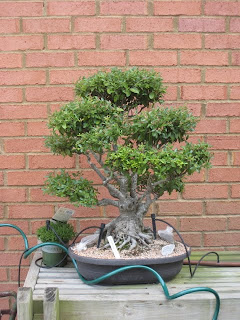I thought we might all benefit from being able to post nuggets of information gleaned from our study group meetings. It's an experiment, of course, since I don't know how much interest there is in interacting online.
In any case, here are a few of my notes from the August 14 meeting. I recorded these suggestions as Rodney was circulating around the room working with individual members. (Please chime in if you see any misinformation or have a different take on a particular bonsai practice.)
October Pine Work
October is a good time to prune black and white pines for structure and to force latent buds to emerge on the interior of trees.
This month is also a good time to repot white pines. (I'm assuming we want to protect the tree from freezing for at least a couple of weeks after repotting.)
It's also a good time to pull third-year needles to allow light into the interior and encourage budding. Some second-year needles can be pulled as well if the tree is vigorous. When pulling needles, it's important to leave the sheath intact, as this is the point where a latent bud may emerge. If you don't know the technique for pulling needles without removing the sheath, you can cut the needles with pruning shears.
February Pine Work
February is a good time to wire pines. Trees will experience a spurt of growth in the spring that will promoting "setting." That is, the cambrium will press against the wire, rupture slightly (ideally), and then heal.
Pest and Disease Control
There are many chemicals for addressing various conditions, but Rodney seems to find lots of utility in using Sunspray Ultra Fine Horticultural Oil. It is particularly valuable as a pest control when used in November and again in February. Some care needs to be taken to avoid spraying trees when the weather is expected to freeze.
Oil can also be used to control Red Spider Mite by spraying trees 3 times x four days apart. It's important to maintain this treatment schedule to interrupt the Mite's life cycle.
You should not spray oil when the temperature is greater than 90 degrees. Leaf burn can result. It's also important to adjust the dilution rate for temperature.
Correction:
Spraying pines with
Cleary's 3336 or copper once a month from April through October is also a good strategy for controlling needle caste.
I went online to order some Sunspray and found out it is no longer being manufactured. As a substitute, I've ordered a one quart bottle of Wipeout. If anyone has any reservations about this product, please let me know (before I spray).
Rotating Trees
Everyone understands that rotating trees during the growing season is a good thing. What most of us don't know is that trees benefit from rotation during dormancy as well. It a good idea to rotate your trees year round every two weeks.
Promoting Good Nebari
Wounding a tree at the base is sometimes suggested as a way to promote new root growth. Rodney suggests that it is actually better to remove an elliptical wedge of tissue. This larger wound prompts a more vigorous healing response and a better chance of root development. It's often desirable to make several of these wounds at once--although you want to avoid aligning them on the truck. Some variation in height is more natural.
Creating a Broom Style
I brought along a Zelkova that I was attempting to style into a broom. I had followed the instructions in Dan Barton's books but was not satisfied with how the tree was progressing.
Rodney noted that my cut was made too high up on the trunk. Branching on a broom usually starts at a point that is fairly low on the trunk in comparison to the ground. Rodney advised that I make a straight cut in early spring just above an obvious bud collar on the trunk. I should then wrap the cut in clear plastic and secure it with wire. After the tree budded, I could select the most promising initial branches to start the broom. At that point I could also make the off-center V cut that would let to give the tree a more natural appearance. (This last step was different from what Dan outlined in his book. With his process, the V cut is made at the same time as the straight cut. But I can see the value in waiting until after budding to make this decision.)






